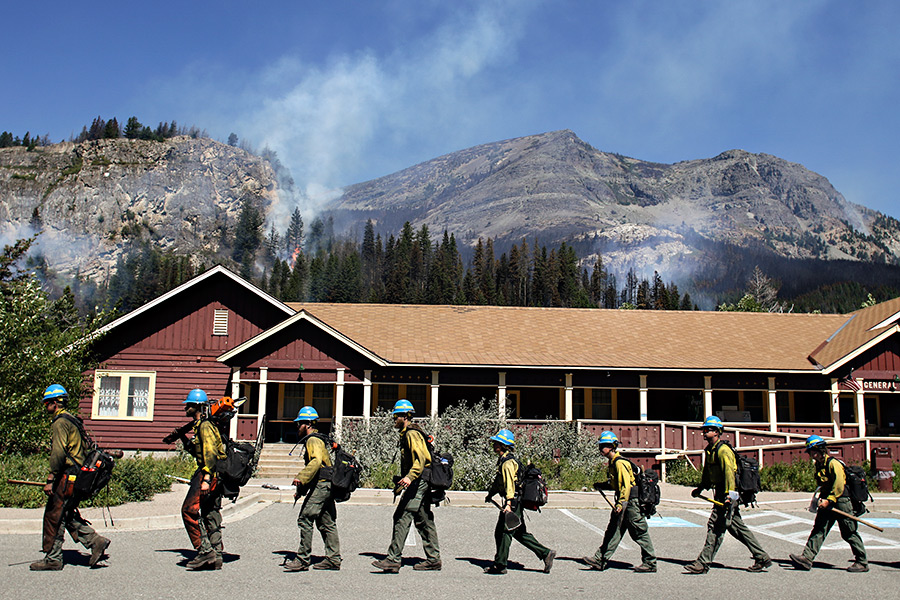Friend and Foe: Wildfire’s Two-Sided Role in the Landscape
As wildfires rage across the West, the nation’s strategy of managing and suppressing fires is more complex than ever
By Dillon Tabish
In only a matter of hours on July 21, a small wildfire east of Logan Pass near Reynolds Creek swelled to over 1,000 acres, chewing through a dense, rugged section of forest plagued by beetle kill and a region afflicted with drought conditions. Over the next two days, the blaze ran through a scenic corridor on the east side of Glacier National Park, forcing hundreds of visitors and residents to evacuate the St. Mary Valley and the temporary partial closure of Going-to-the-Sun Road.
Two weeks later, over 700 personnel, including multiple helicopters and one of the nation’s highest qualified firefighting teams, have battled the nearly 4,000-acre fire. The Type I incident management team, led by Kalispell’s Greg Poncin, has thrown almost everything at its disposal at the fire, including explosives that were used to build a 4,000-foot fire line in an avalanche chute with heavy brush and downed logs. The incident has cost over $8 million but it remains largely contained. The Sun Road has reopened to Logan Pass on the west side and many of the evacuated sites are welcoming back visitors and homeowners.
Initial evidence suggests that the fire may be human caused, and the National Park Service is asking for anyone who traveled in the area of Reynolds Creek on the Gunsight Pass Trail or stayed at a backcountry campsite between July 14 and July 21 to contact (888) 653-0009.
The dogged effort by Poncin’s team illustrates the modern requirements of combating America’s persistent siege of wildfires in an era defined by extreme fire behavior. But it also reflects a pivotal moment for the nation’s strategy of addressing fires on the landscape, especially in national parks and wilderness areas.
Since the 1960s, the National Park Service has followed a policy of managing its sites as “vignettes of primitive America.” A major shift occurred in the agency’s approach to fire, from suppressing all blazes to managing fire as a natural element in the landscape. This included the permitted use of prescribed burning and allowing lightning fires to burn naturally, unless human safety or cultural resources became threatened.
Yet, in the midst of another nationwide scorching, the policy of “let it burn” appears more complicated than ever. Fire managers are under increasing pressure from communities such as the Flathead Valley that depend on the tourism season in Glacier National Park as the main economic driver. There is also the increased population of homes on the outskirts of national parks and wildernesses, creating a crowded wildland urban interface that raises safety concerns whenever a blaze breaks out.
And, of course, the conditions are ripe for large, fast-growing incidents such as the Reynolds Creek Fire.
“Climate change, beetle kill, drought conditions, lower snowpack — that is all definitely making it tougher to decide when and where to allow fires to burn,” Dan Buckley, fire director for the National Park Service, said. “Plus the fact that there are more homes and buildings in the wildland urban interface — these incidents are more complex for sure.”
Buckley said the agency relies on local managers, such as park superintendents, to decide the level of suppression whenever a fire breaks out.
Jeff Mow, superintendent in Glacier Park, told attendees at a recent public meeting in West Glacier that effects of climate change could change the way agencies such as the Park Service respond to blazes.
“I’m not sure it changes the way we fight wildfires, but our windows of opportunity have changed,” he said. “In some cases, our opportunities to use fire the way we use it naturally aren’t going to present themselves quite the same way.”
The National Park Service manages 408 parks and more than 84 million acres across the U.S. In fiscal year 2015, the agency had 195 unplanned ignitions that burned 98,540 acres. In 2014, 72,133 acres burned; in 2013, 209,195 acres were scorched; and in 2012, 146,007 acres burned.
Last year over 75,000 acres were treated through prescribed burns in the wildland urban interface of national parks and 2,471 were treated in non-wildand urban interface lands.
Peter Kolb, an associate professor of forest ecology and management at the University of Montana, said federal agencies such as the NPS could have to alter their strategies for managing fires in the coming years due to America’s fire conditions.
“We went from a full control, full suppression philosophy to now letting nature do its thing. We’re finding that if we let nature do its own thing, it’s not always beneficial to us,” Kolb said. “How do we meld the two philosophies together? Glacier National Park is one of those places where we want to leave nature to its own devices. But at the same time, without any mitigation, it may not provide us with the habitat that we’re looking for.”
For centuries, wildfire has played a prominent and important role in the landscape, Kolb said. But the expansion of civilization around these forested areas — and the latest extreme fire conditions that persist across the West — are punctuating the need for evaluating how to coexist with fire.
“How can we be a benign steward to the landscape and keep what we call the natural process, but not let the same process destroy what we cherish?” Kolb said. “That’s a difficult medium to find.”